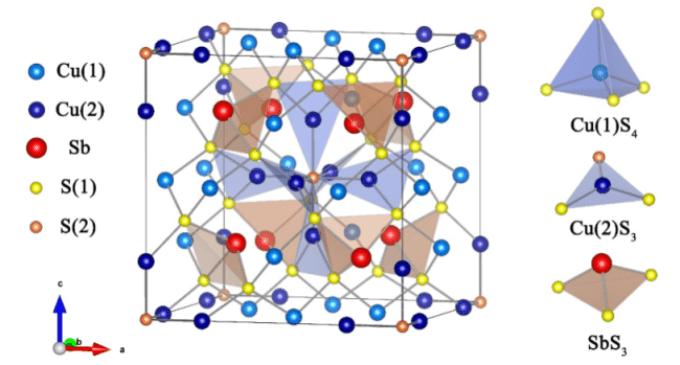Jun 17 2019
Chinese scientists have announced that they have realized high thermoelectric performance of Cu12Sb4S13 tetrahedrites by doping Ge at Sb site and introducing ZnO to ulterior optimization of the thermal and electrical transport properties at the same time.
 The crystal structure of tetrahedrites Cu12Sb4S13. (Image credit: HUANG Lulu)
The crystal structure of tetrahedrites Cu12Sb4S13. (Image credit: HUANG Lulu)
This research was conducted by QIN Xiaoying and his group with the Institute of Solid State Physics (ISSP), Hefei Institutes of Physical Science of the Chinese Academy of Sciences. Furthermore, they achieved the maximum ZT of approximately 1.0 at 750 K for Cu12Sb3.96Ge0.04S13-0.5 wt.% ZnO sample through their research.
Alternative energy sources are of high demand around the world, and eco-friendly thermoelectric technology is expected to produce electric power from waste heat. Thermoelectric materials are functional materials with significant market potential and wide application possibilities.
Thermoelectric power generation systems exploit waste heat (for example, from thermal power plants and automobile exhausts) to produce electricity and achieve the recycling of waste heat to enhance the fossil energy utilization rate.
In recent times, PbTe and Bi2Te3 have been regarded as the perfect thermoelectric material because of its conversion performance. However, they are constrained in large-scale industrial applications because of the low crust content of Te element and the pollution while preparing and using Pb element. After that, Pb and Te free materials Cu12Sb4S13 tetrahedrites gained extensive attention as a potential, eco-friendly thermoelectric material.
Meanwhile, Cu12Sb4S13 tetrahedrites are established to have inherently low, glass-like lattice thermal conductivity (0.5–1.00 W m-1 K-1 above room temperature) because of its intricate crystal structure.
As reported in the research, the outcomes showed that Ge doped at Sb site could result in resonance distortion of state of density to enhance the power factor and achieve an approximately 30% larger thermoelectric performance. Moreover, it was a very effective method for Cu12Sb4S13 tetrahedrites to enhance the thermoelectric performance by increasing the power factor by element doping initially and subsequently decreasing the thermal conductivity by incorporating nanoparticles.
This study was supported by the Natural Science Foundation of China, the National Key Research and Development Program from the Ministry of Science and Technology of China, and the research contribution of the Super Computing Center of USTC.
The research, reported in ACS Applied Materials & Interfaces, by QIN and his group may cast new light on this research field.